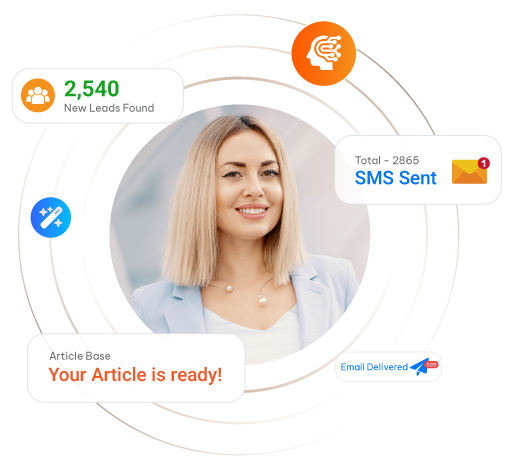Automated follow-up for unresponsive leads is crucial in B2B sales, reviving dormant prospects and boosting conversions. By using AI tools, businesses can efficiently re-engage silent leads, increasing response rates and closing deals faster. This approach saves time and enhances sales team productivity.
TL;DR
- Up to 70% of B2B leads go cold without proper follow-up, leading to significant revenue loss. Automated follow-up systems can revive these leads efficiently.
- Automation tools send timely, personalized messages, increasing response rates and closing deals faster, while freeing up sales teams to focus on high-value tasks.
- Companies using automated follow-up see a 40% increase in engagement, making it a competitive necessity in industries with long sales cycles like SaaS.
- Effective tools like CloudApper AI Outreach Agent segment leads and adjust campaigns in real-time, operating 24/7 without additional staff.
- Implementing automated follow-up involves integrating with CRM systems, defining customer profiles, and tracking key metrics to optimize performance.
- To avoid common pitfalls, ensure message variety and value, and use data analytics to refine strategies continuously.
- Future trends include more AI integration and predictive analytics, enhancing efficiency and engagement.
- Automated follow-up transforms dormant prospects into active opportunities, driving growth and increasing conversions.
Ready to boost your B2B conversions? Contact us to explore the best automated follow-up solutions for your business.
Did you know that up to 70% of B2B leads go cold without proper follow-up, costing companies millions in lost revenue? Automated follow-up for unresponsive leads fixes this problem fast. In the busy world of B2B sales, prospects often vanish after the first contact. However, teams can bring them back with smart automation tools. For example, these systems send timely messages without manual effort, boosting conversions and keeping pipelines full. Therefore, businesses turn to solutions like AI agents to handle this efficiently.
For more information on CloudApper AI RevOps visit our page here.
What is automated follow-up for unresponsive leads? This approach uses technology to detect silent prospects and re-engage them automatically. Sales reps no longer chase every lead by hand. Instead, the system triggers emails, SMS, or calls based on behavior. For instance, if a lead ignores an initial email, the tool sends a personalized nudge a few days later. As a result, response rates climb, and deals close faster. Moreover, this method saves time, allowing teams to focus on high-value tasks.
Why choose automated follow-up for unresponsive leads in B2B? Long sales cycles make it easy for prospects to drop off. However, automation keeps the conversation alive. A recent study shows that companies using these tools see a 40% increase in engagement. Therefore, B2B firms adopt them to stay competitive. For example, in SaaS industries, where leads might take months to decide, consistent follow-ups build trust. Additionally, personalization makes messages feel relevant, not spammy.
How does automated follow-up for unresponsive leads work? The process starts with monitoring lead activity. Tools scan for signs of inactivity, like no opens or replies. Then, they launch sequences tailored to the prospects needs. For instance, a lead who viewed a demo but went quiet might get a case study via email. However, if email fails, the system switches to SMS for better reach. As a result, multi-channel strategies increase success. Furthermore, AI analyzes data to refine these sequences over time.
Best tools for automated follow-up for unresponsive leads include options like CloudApper AI Outreach Agent. This agent segments leads based on behavior and history. Therefore, it sends the right message at the right time. For example, it groups prospects by industry or engagement level. Moreover, real-time adjustments ensure campaigns improve continuously. Teams appreciate the dashboards that display key metrics clearly. However, the real power lies in its ability to operate 24/7 without extra staff.
Benefits of automated follow-up for unresponsive leads shine in real scenarios. Consider a marketing tech company with thousands of leads. Many went dormant after demos. By implementing automation, they revived 25% more discussions. Therefore, conversions rose, and revenue grew. For instance, sequences included day-three emails and week-two SMS reminders. As a result, the team closed deals they once thought lost. Additionally, data from these efforts helped tweak strategies for even better outcomes.
How to implement automated follow-up for unresponsive leads starts with choosing the right tool. First, integrate it with your CRM for seamless data flow. Then, define customer profiles to guide segmentation. For example, set rules for inactivity triggers. However, test small campaigns to see what works. Moreover, track metrics like response rates to optimize. Therefore, teams quickly see improvements in efficiency and sales.
Common mistakes in automated follow-up for unresponsive leads include over-sending messages. Prospects might feel bombarded if sequences lack variety. However, spacing them out and adding value prevents this. For instance, include helpful resources like webinars or guides. As a result, leads engage more willingly. Furthermore, ignoring data leads to poor performance, so always review analytics.
Case studies on automated follow-up for unresponsive leads highlight success stories. A SaaS provider faced stagnant pipelines. They adopted an AI tool and saw response rates jump 40%. Therefore, their sales cycle shortened by weeks. For example, personalized follow-ups referenced past interactions, rekindling interest. Moreover, the team used insights to focus on high-potential leads. However, the key was consistent, automated contact that manual methods could not match.
Metrics to track in automated follow-up for unresponsive leads ensure ongoing success. Monitor response rates to gauge message impact. Open rates reveal initial appeal. However, conversion progress shows how leads move through stages. For instance, an engagement score prioritizes hot prospects. Additionally, drop-off rates highlight weak spots. Therefore, adjust based on these numbers for better results.
Future trends in automated follow-up for unresponsive leads point to more AI integration. By 2026, most enterprises will use such tools for engagement. However, advancements like predictive analytics will forecast lead behavior. For example, systems might predict the best time to follow up. As a result, efficiency skyrockets. Moreover, combining with other tech like chatbots enhances the process.
Tips for optimizing automated follow-up for unresponsive leads include personalizing content. Use data to tailor messages. However, keep language simple and direct. For instance, ask questions that prompt replies. Therefore, prospects feel valued. Additionally, vary channels to reach them effectively. Moreover, A/B test sequences to find winners.
Challenges with automated follow-up for unresponsive leads can arise from integration issues. Some tools do not sync well with existing systems. However, choosing compatible ones solves this. For example, CloudApper integrates easily. As a result, setup takes minimal time. Furthermore, privacy concerns matter, so ensure compliance with regulations.
ROI of automated follow-up for unresponsive leads justifies the investment. Companies report higher revenue from revived leads. Therefore, the cost pays off quickly. For instance, reduced manual labor saves hours weekly. Moreover, scalable growth handles more leads without added hires. However, measuring ROI through metrics like deal value confirms the benefits.
How automated follow-up for unresponsive leads boosts conversions ties back to persistence. Silent leads often need multiple touches. However, automation provides them consistently. For example, sequences nurture without overwhelming reps. As a result, more prospects convert. Additionally, data-driven refinements make each campaign stronger.
In B2B SaaS, automated follow-up for unresponsive leads transforms dormant prospects into active opportunities. Teams revive interest efficiently, driving growth. Therefore, adopting these tools positions businesses for success. For example, with real-time tracking, decisions become smarter. Moreover, the efficiency gains free resources for strategy. However, the ultimate win is higher conversions and steady revenue.
Reviving dormant prospects through automated follow-up for unresponsive leads requires action now. Start by exploring tools that fit your needs. However, remember to focus on personalization and data. As a result, your sales pipeline will thrive. Furthermore, staying ahead of trends ensures long-term advantages.
Automated follow-up for unresponsive leads stands as a game-changer for B2B teams. It tackles the challenge of silent leads head-on. Therefore, embrace it to boost efficiency and results. For instance, successful implementations show clear paths to better performance. Moreover, continuous improvement keeps your edge sharp.

Scale Revenue Without Hiring More People
Meet the AI Team Behind Your Revenue Growth
CloudApper’s AI Revenue Operations Team helps you scale without the cost and complexity of hiring.
Learn more | Download BrochureFrequently Asked Questions (FAQ)
What is automated follow-up for unresponsive leads?
Automated follow-up for unresponsive leads utilizes technology to re-engage prospects who have become inactive. Systems can send personalized messages like emails, SMS, or calls based on the lead's behavior, increasing response rates and accelerating deal closings. Learn more about the benefits of automated follow-up.
Why is automated follow-up important in B2B sales?
B2B sales often have long cycles, making it easy for prospects to drop off. Automation helps maintain active communication with leads, shown to boost engagement by up to 40%. This is particularly effective in SaaS industries where lead nurturing builds trust over time. Find out how automation can boost conversions and keep pipelines full.
How does automated follow-up for unresponsive leads work?
This process involves monitoring lead activity and automatically triggering communication based on inactivity. If email fails, the system may switch to SMS for better outreach. This multi-channel approach increases the chances of re-engagement. Discover how multi-channel strategies increase success.
What tools are best for automated follow-up?
Tools like CloudApper AI Outreach Agent are highly effective. They segment leads based on behavior and send tailored messages at optimal times, while offering dashboards that display key metrics clearly.
What are common mistakes with automated follow-up?
Common pitfalls include over-sending messages, which can overwhelm prospects, and not utilizing analytics effectively. However, adding value through relevant resources like webinars can enhance engagement.
What is CloudApper AI Platform?
CloudApper AI is an advanced platform that enables organizations to integrate AI into their existing enterprise systems effortlessly, without the need for technical expertise, costly development, or upgrading the underlying infrastructure. By transforming legacy systems into AI-capable solutions, CloudApper allows companies to harness the power of Generative AI quickly and efficiently. This approach has been successfully implemented with leading systems like UKG, Workday, Oracle, Paradox, Amazon AWS Bedrock and can be applied across various industries, helping businesses enhance productivity, automate processes, and gain deeper insights without the usual complexities. With CloudApper AI, you can start experiencing the transformative benefits of AI today. Learn More
AI RevOps Agent
Scale Revenue Without Hiring More People
Download Brochure


Amplifier Agent
Keeps Your Brand Visible With Articles & Social Media Content That Connects.
Learn More
Outreach Agent
Launches Email & SMS Campaigns That Reach Out on Time and Actually Convert.
Learn More


- Works with
Similar Posts

Strengthen SaaS Trial Lead Recovery Through Automated Multi-Channel Reminders

Automated Lead Segmentation and Follow-Up Tactics for SaaS Outreach Growth

















